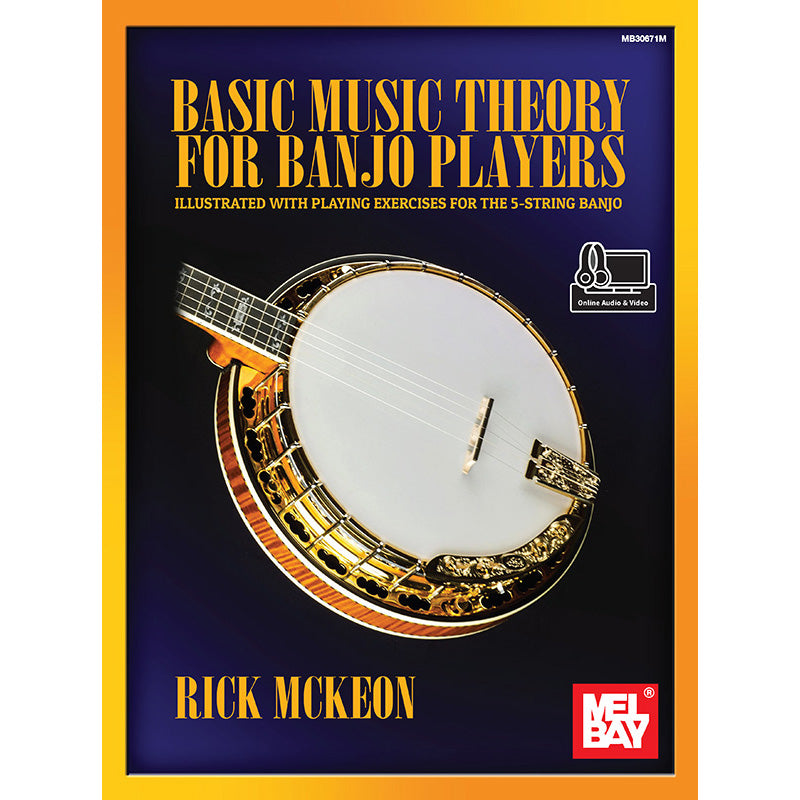-
 Book with online audio & video. A "hands-on" approach to music theory with lots of playing examples for banjo. Music theory does not have to be mysterious or difficult. Taken a little at a time, it’s easy and fun, plus you're encouraged to “jump around and spend more time in those areas that interest you most.” Each of these 50 lessons has a limited scope, but by the time you complete them, you'll have a thorough understanding of the basics of music theory. Covers topics that address the needs of most beginning banjo players: scale theory, reading tablature and standard notation, key signatures, accidentals, transposition, time signatures and note values, intervals and chord construction, pentatonic scales, more. Each chapter features playing examples and review questions to test and clarify your understanding. Mostly diagrams with some note/tab. 160 pp.
Book with online audio & video. A "hands-on" approach to music theory with lots of playing examples for banjo. Music theory does not have to be mysterious or difficult. Taken a little at a time, it’s easy and fun, plus you're encouraged to “jump around and spend more time in those areas that interest you most.” Each of these 50 lessons has a limited scope, but by the time you complete them, you'll have a thorough understanding of the basics of music theory. Covers topics that address the needs of most beginning banjo players: scale theory, reading tablature and standard notation, key signatures, accidentals, transposition, time signatures and note values, intervals and chord construction, pentatonic scales, more. Each chapter features playing examples and review questions to test and clarify your understanding. Mostly diagrams with some note/tab. 160 pp.
The exact appearance of this item may vary.
More Details
More Details
More Details
Chapter 1. The Major Scale
1.1 The Major Scale is the Basis of All Music Theory!
1.2 Producing Musical Sounds
1.3 Whole Steps and Half Steps
1.4 What is a Major Scale?
1.5 Playing Examples
1.6 Review Questions for Chapter 1
Chapter 2. Reading Notation and Tablature
2.1 Overview
2.2 Reading Tablature
2.3 Reading Standard Music Notation
2.4 Musical Symbols and Song Structure
2.5 Playing Examples
2.6 Review Questions for Chapter 2
Chapter 3. Key Signatures
3.1 What is a Key Signature?
3.2 Why Even Have Different Keys?
3.3 Accidentals
3.4 Transposing Between Major Keys
3.5 Transposing Instrumentals
3.6 Playing Examples
3.7 Review Questions for Chapter 3
Chapter 4. Timing
4.1 Overview: Timing Is Everything!
4.2 Time Signatures
4.3 Note Values and Counting
4.4 Rests
Chapter 5. Musical Intervals
5.1 Overview: It's Like Using a Ruler
5.2 Musical Intervals Have a First Name and a Last Name
5.3 Easy Ways to Remember the Sound of Intervals
5.4 Pitch Names
5.5 Playing Examples
5.6 Review Questions for Chapter 5
Chapter 6. Chord Construction
6.1 Overview: What is Harmony?
6.2 The Triad and Stacked Thirds
6.3 Major, Minor and Seventh Chords
6.4 Open Voicing
6.5 Chord Inversions and X/Y Chords
6.6 Chord Extensions
6.7 Partial Chords
6.8 Each Chord Has a Voice
6.9 Playing Examples
6.10 Review Questions for Chapter 6
Chapter 7. Chords in a Key
7.1 Stacked Thirds: The triad
7.2 Another Way to Look at It
7.3 Stacked Thirds: Seventh Chords
7.4 You Are Not LockedInto Anything: Accidentals
7.5 Playing Examples
7.6 Review Questions for Chapter 7
Chapter 8. Movable Chords
8.1 What are Movable Chords?
8.2 Movable Chords for the Banjo
8.3 Using a Capo
8.4 Playing Examples
8.5 Review Questions for Chapter 8
Chapter 9. The Nashville Number System
9.1 Play by the Numbers
9.2 Where's the Root?
9.3 NNS Notation
9.4 The Relative Minor
9.5 Playing out of the "Home Position"
9.6 The 12-Bar Blues
9.7 Playing Examples
9.8 Review Questions for Chapter 9
Chapter 10. Minor Scales and Modes
10.1 The Natural Minor Scale
10.2 The Harmonic Minor Scale
10.3 The Melodic Minor Scale
10.4 The Minor Pentatonic and Blues Scales
10.5 Modes
10.6 Playing Examples
10.7 Review Questions for Chapter 10
Chapter 11. Answers to Review Questions
Meet the Author
Basic Music Theory for Banjo Players
Basic Music Theory for Banjo Players
SKU: 02-30671M
Couldn't load pickup availability
More Details
More Details
Chapter 1. The Major Scale
1.1 The Major Scale is the Basis of All Music Theory!
1.2 Producing Musical Sounds
1.3 Whole Steps and Half Steps
1.4 What is a Major Scale?
1.5 Playing Examples
1.6 Review Questions for Chapter 1
Chapter 2. Reading Notation and Tablature
2.1 Overview
2.2 Reading Tablature
2.3 Reading Standard Music Notation
2.4 Musical Symbols and Song Structure
2.5 Playing Examples
2.6 Review Questions for Chapter 2
Chapter 3. Key Signatures
3.1 What is a Key Signature?
3.2 Why Even Have Different Keys?
3.3 Accidentals
3.4 Transposing Between Major Keys
3.5 Transposing Instrumentals
3.6 Playing Examples
3.7 Review Questions for Chapter 3
Chapter 4. Timing
4.1 Overview: Timing Is Everything!
4.2 Time Signatures
4.3 Note Values and Counting
4.4 Rests
Chapter 5. Musical Intervals
5.1 Overview: It's Like Using a Ruler
5.2 Musical Intervals Have a First Name and a Last Name
5.3 Easy Ways to Remember the Sound of Intervals
5.4 Pitch Names
5.5 Playing Examples
5.6 Review Questions for Chapter 5
Chapter 6. Chord Construction
6.1 Overview: What is Harmony?
6.2 The Triad and Stacked Thirds
6.3 Major, Minor and Seventh Chords
6.4 Open Voicing
6.5 Chord Inversions and X/Y Chords
6.6 Chord Extensions
6.7 Partial Chords
6.8 Each Chord Has a Voice
6.9 Playing Examples
6.10 Review Questions for Chapter 6
Chapter 7. Chords in a Key
7.1 Stacked Thirds: The triad
7.2 Another Way to Look at It
7.3 Stacked Thirds: Seventh Chords
7.4 You Are Not LockedInto Anything: Accidentals
7.5 Playing Examples
7.6 Review Questions for Chapter 7
Chapter 8. Movable Chords
8.1 What are Movable Chords?
8.2 Movable Chords for the Banjo
8.3 Using a Capo
8.4 Playing Examples
8.5 Review Questions for Chapter 8
Chapter 9. The Nashville Number System
9.1 Play by the Numbers
9.2 Where's the Root?
9.3 NNS Notation
9.4 The Relative Minor
9.5 Playing out of the "Home Position"
9.6 The 12-Bar Blues
9.7 Playing Examples
9.8 Review Questions for Chapter 9
Chapter 10. Minor Scales and Modes
10.1 The Natural Minor Scale
10.2 The Harmonic Minor Scale
10.3 The Melodic Minor Scale
10.4 The Minor Pentatonic and Blues Scales
10.5 Modes
10.6 Playing Examples
10.7 Review Questions for Chapter 10
Chapter 11. Answers to Review Questions
Meet the Author



